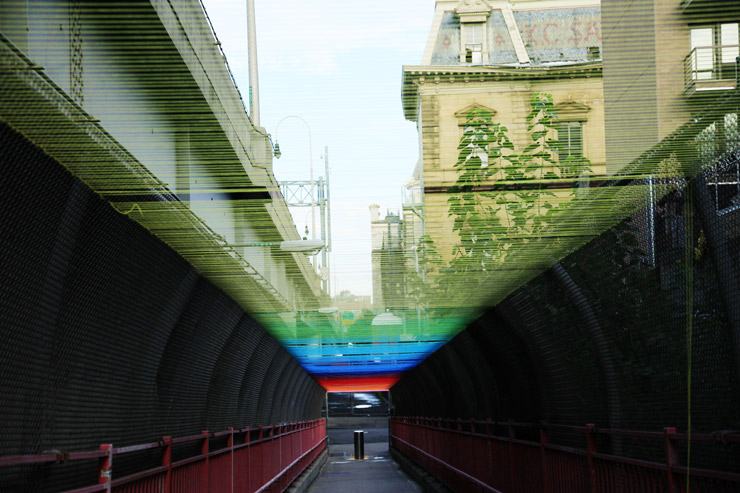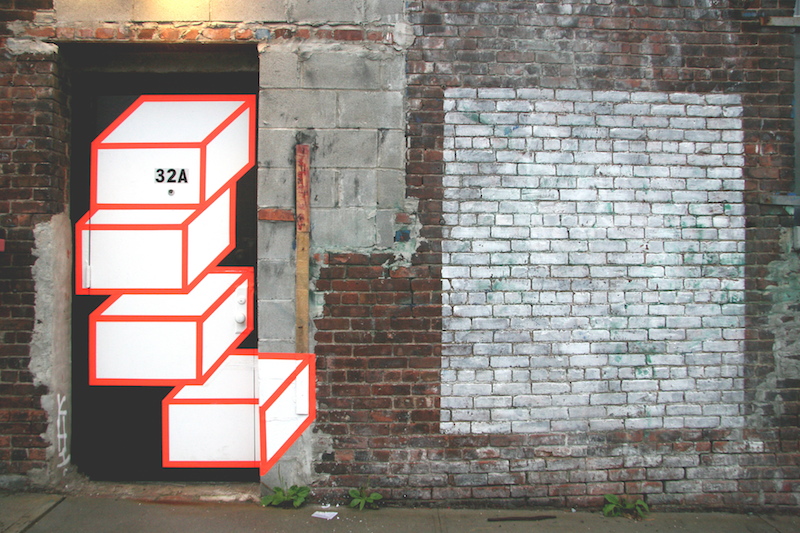
Hot Tea yarn bombed the pedestrian section of the Williamsburg Bridge. Photo by Jaime Rojo.
Tape art and yarn bombing are two similar styles of street art that, like ad takeovers, have experienced growing popularity facilitated by the internet. Both tape art and yarn bombs generally have a short lifespan. Although the pieces may stay up for a while, their decay is often quick and ugly. While a Swoon wheatpaste can be revisited again and again as it ages like a fine wine, a yarn bombs and tape art tend to rot. The best time to see them is moments after they have been installed, which is why good documentation is so essential to such a work’s success.
In the fall of 2012, I was in Stavanger, Norway for the Nuart festival. While walking around Stavanger one evening, I stumbled upon a piece by the tape artist Aakash Nihalani. It couldn’t have been more than a couple of days old, but it already looked like crap. In Ian Cox’s photo of the piece, it looks like classic work by Nihalani. It looks fun and site-specific, and the photo even includes a young boy interacting with the piece. As Cox says, “so simple yet so effective.” Unfortunately, by the time I found the same piece in person, it was already falling apart. The illusion was destroyed and now there was just dayglo tape falling off a wall.

Relatively fresh street art made of tape by Aakash Nihalani. Photo by Ray Mock.
Street artists working with yarn, generally under the umbrella of yarn bombing, have a similar problem. Artists like Hot Tea or Spidertag have the best-case scenario since their work quickly goes from this or this, to something like this. In those cases, at least the work falls away without becoming a complete eyesore. More traditional yarn bombs start out looking like this, but decay to something more like this or this. Decayed yarn bombs do not always look terrible, but they definitely look best on day one, and it isn’t long before the decay begins and the yarn bomb turns into a strange sort of urban mold that can last for months. Maybe you don’t mind a decaying yarn bomb and I’m just hater, but I’ve never seen photos depicting a months-old yarn bomb shared on Facebook with the caption “This thing looks so cool. I’m glad it’s stayed up for so long.”
Street art is ephemeral, it decays. But most good street art decays with a sort of grace, looking interesting or sometimes even better as it seems to sink into the wall and into the urban cacophony. Yarn bombs and tape art don’t do that. They are at their most beautiful and interesting from the moment they are put up until it rains, and then they are practically trash. But many of the artists working in these mediums are smart enough to take good photos of their work as soon as it is up, and those photos can be shared online to show the piece in an eternally pristine state. Without the internet, I think it’s unlikely that either of these mediums, particularly tape art (since yarn bombing also has a feminist appeal), would be as popular as they are.